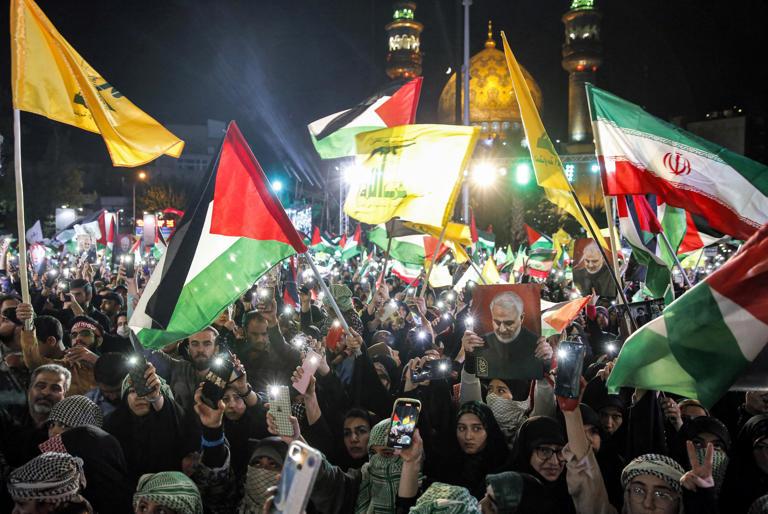
Hamas Is Evil. Hezbollah Is Just as Evil and Better Equipped | Opinion
Since the Hamas invasion of Israel on Oct. 7, the world has been exposed to unimaginable images.
Infants slaughtered. Families burned alive. Festival goers mowed down. A disabled grandmother taken captive. A Holocaust survivor executed. A child hostage taunted on camera. Victims’ credit cards used, their families receiving a call with nothing but a laugh. A woman’s near-naked body paraded to shouts of “God is great”—and spat upon by a jeering crowd in Gaza.
It’s clear that Hamas, the supposedly devout group that violently wrested control of Gaza from other Palestinians more than 16 years ago, was badly underestimated by foreign intelligence agencies, and even by Israel.
But frighteningly, Hamas is just the tip of the iceberg when it comes to Iran’s portfolio of terrorist proxies.
It’s past time to be reacquainted with Hezbollah.
Like Hamas, Hezbollah in Lebanon is a non-state actor with a stranglehold on government. It, too, is a “political party” with the hardware of a military but none of the legal or operational constraints. Like Hamas, Hezbollah is financed, armed, trained, and guided by Iran. And Hezbollah, like Hamas and Iran itself, is openly sworn to Israel’s destruction.
Like Hamas, which invaded the Jewish state despite the latter’s total withdrawal from Gaza in 2005, Hezbollah has continued to wage war on Israelis after their complete pullout from a former security zone along the Lebanese border in 2000.
Both Hamas and Hezbollah have launched relentless missile attacks from among their own civilians and engaged in repeated hostage-taking. Despite intensifying economic malaise in their societies, both have incited and profited from violence, diverted aid, and invested incalculable resources in burrowing underground tunnels deep into Israel. Both have cultivated a significant support base, using a mix of brute force, control over social services, media manipulation, and a fanatic ideology tapping into religious and nationalist zeal. Both have tried, with some success, to present a false distinction between their political and armed wings.
But that’s where the similarities end.
In addition to the fact that Hezbollah, unlike Hamas, is Shi’ite—and more explicitly devoted to Iran’s supreme leader and his “revolutionary” forces—the geographical link between Hezbollah and the Islamic Republic is much more direct. Unlike Gaza, bordered by Israel and Egypt—a country vigilant toward the Muslim Brotherhood, whose Palestinian offshoot is Hamas—personnel and weaponry can reach Hezbollah-dominated Lebanon almost unimpeded through Syria and Iraq. Both of those governments—especially Syria’s Assad regime, whose rule was sustained by Iran during a civil war that killed more Arabs in 10 years than the Arab-Israeli conflict has in 75—are indebted to Tehran’s theocrats. And Hezbollah has garnered critical combat experience in Syria’s bloody war, which saw state use of chemical weapons.
The offensive capabilities of Hezbollah are sobering. Compared with the nearly 30,000 armed operatives recently attributed to Hamas, Hezbollah may have 50,000 and its leader claims double that. While Hamas and Iran-backed Islamic Jihad were said to have perhaps 12,000 rockets in Gaza well before the current onslaught—and have already fired more than 7,300 since Oct. 7—Hezbollah is estimated to have at least 150,000 missiles. Hamas’ firepower is believed to have a reach of 143 miles, but Hezbollah’s arsenal is far more advanced, with a range that the group’s chief, Hassan Nasrallah, says can reach anywhere in Israel.
Indeed, barely the size of New Jersey, Israel has a population overwhelmingly concentrated in the small area between Gaza and Lebanon—and Hamas and Hezbollah have again this week fired indiscriminately from both Israel’s south and north. If Hezbollah were to unleash a fuller assault on Israel, as it did in 2006, the results are likely to be beyond devastating for Israelis and Lebanese alike. And that is without any direct participation by Iran, which has funneled as much as $700 million to Hezbollah annually, compared with “merely” $100 million for Hamas.
Iran and its proxies have already been incriminated in terrorism not only in Israel and Lebanon, but also in Saudi Arabia, the United Arab Emirates, Yemen, Argentina, Bulgaria, India, and elsewhere. Most recently, Iranian drones have exacerbated the bloodletting in Ukraine.
Yet on Wednesday, even as Hezbollah has routinely impeded United Nations peacekeepers in Lebanon, U.N. Security Council restrictions on Iran’s missile program were allowed to expire without any action by the world body. And on Sept. 29, the Pentagon affirmed that Iran has reached the capacity to produce enough fissile material for a nuclear bomb within less than two weeks.
For decades, the United States has recognized Iran—which ritually pledges “death to America, death to Israel”—as the leading state-sponsor of terror. Hezbollah, for its part, was long ago dubbed the “A-team” of international terrorists.
All responsible global stakeholders must act before, not after, Hezbollah and Iran escalate their program of mass murder and mayhem.
Source » msn.com





